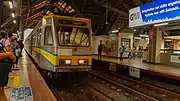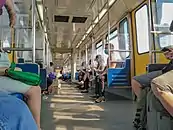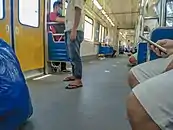LRTA 1100 class
The LRTA 1100 class is a high-floor LRV of the Light Rail Transit Authority (LRTA) in Manila, Philippines, which began operation in 1999.[6][9]
| LRTA 1100 class Second-generation LRV | |
|---|---|
 A 1100 class train approaching Carriedo station | |
| In service | 1999–present |
| Manufacturer | Carbody: Hyundai Precision Electrical components: ADtranz |
| Assembly | Changwon, South Korea |
| Constructed | 1997–1998 |
| Entered service | 1999 |
| Refurbished | 2019–2020 |
| Number built | 28 vehicles[1] |
| Number in service | 24 vehicles (6 sets) |
| Formation | 4 cars per trainset (mono-articulated car body) |
| Fleet numbers | 1101–1128 |
| Capacity | 347 passengers per car[1] |
| Operator(s) | Light Rail Transit Authority Light Rail Manila Corporation |
| Depot(s) | Baclaran |
| Line(s) served | Line 1 |
| Specifications | |
| Car body construction | Stainless steel |
| Train length | 3–car trainset: 79,350 mm (260 ft 4 in) 4–car trainset: 105,700 mm (346 ft 9 in) |
| Car length | Motor head cars with driving cab 26,500 mm (86 ft 11 in) Motor intermediate cars 26,350 mm (86 ft 5 in) |
| Width | 2,590 mm (8 ft 6 in) |
| Height | From top of rail: 3,525 mm (11 ft 6.8 in) Pantograph locked down: 3,950 mm (13 ft 0 in) |
| Floor height | 920 mm (3 ft 0 in) |
| Doors | 4 per side, sliding pocket-type |
| Wheel diameter | 660 mm (new) |
| Maximum speed | 60 km/h (37 mph) |
| Weight | Head car: 37.4 t (37,400 kg) Intermediate car: 36.5 t (36,500 kg) |
| Traction system | Original: Adtranz IGBT-VVVF Refurbished: Voith IGBT-VVVF |
| Traction motors | Three-phase, AC induction motor |
| Power output | Original: 125kW Refurbished: 170kW |
| Acceleration | 1.0 m/s2 |
| Deceleration | Service: 1.3 m/s2 Emergency: 2.08 m/s2 |
| Electric system(s) | 750 V DC overhead wire |
| Current collection method | Single-arm pantograph |
| Bogies | Outside-frame type |
| Safety system(s) | ATS, ATP |
| Track gauge | 1,435 mm (4 ft 8 1⁄2 in) |
| Notes | |
| Key features are based from these references.[2][3][4][5][6][7][8] | |
History
To enhance the transportation capacity of Line 1, between 1997 and 1998, 28 cars (7 sets) are produced by Hyundai Precision as its first manufactured light rail vehicle.[10] The capacity extension project was due to traffic congestion and air pollution, which in turn led to an increased demand for public transport in Metro Manila by the LRT Line 1. [11][12][13][14][15]
The handover ceremony and test-run of the 1100 series LRV was done with former President Joseph Estrada and former Vice-President Gloria Macapagal Arroyo.
Design
Structure
The train car body is made of stainless steel, and similar to the 1000 class, the 1100 class have cheatlines of blue and yellow that run through its sides. The trains also served as a prototype for future LRVs made by Hyundai Precision, which bears resemblance to the trains used in the Adana Metro and the Istanbul T4 Line.
 1100 class train at train platform.
1100 class train at train platform..jpg.webp) Image shows stanchions, ACU vents, and briefly, the builders' plate.
Image shows stanchions, ACU vents, and briefly, the builders' plate.
Interior
The trains have longitudinal seating. A wheelchair provision is present near the articulated portion of the intermediate cars.
 1100 class interior.
1100 class interior. 1100 class train with seats removed, showing wheelchair space.
1100 class train with seats removed, showing wheelchair space.
Drive unit
Traction control system is IGBT-VVVF type. The traction motor is a three-phase induction motor (enclosed type). The trainset produces a distinct high-pitched acceleration sound that is unique to the Adtranz VVVF controller used.
The original VVVF controller is supplied by ADtranz, while the new VVVF controller done during the refurbishment period is supplied by Voith. The change of VVVF controller is due to Adtranz no longer able to supply spare parts as it changed management and ownership.
Operations
The 1100 class entered service in 1999, which raised the line's capacity by half.[16] After 2001, many vehicles left the service owing to problems in operations and maintenance.[17] Although spare parts had been substantially given in 2004, 14 cars remained out-of-service due to the lack thereof as of 2013, with two cars inoperable after a collision.[18][19][20][21]
2 out of the 7 sets remained in service. Rehabilitation was initiated by LRMC in 2018, which aimed to restore the inactive fleet into serviceable conditions and increase the capacity of Line 1. LRMC and Voith signed an agreement to refurbish the said fleet which includes the control devices, traction systems, and automatic diagnostic displays of main circuits.[22][4] The refurbishment was carried out between 2019 and 2020 and 6 out of 7 sets returned to operation with an extended vehicle life.[3]
In addition, these trainsets are commonly used as "skip trains" or trains meant to target a particular station due to extremely high volume of passengers, especially at rush hours.
References
- "MANILA LRT1 EXTENSION, OPERATIONS AND MAINTENANCE PROJECT" (PDF). The Official Site Public-Private Partnership Center of the Philippines. June 2012. Retrieved April 9, 2018.
- DOTC & LRTA 2012, p. 10.
- "Electric traction system Modernization of light rail trains Light Rail Manila Corporation" (PDF). Voith. Retrieved May 27, 2020.
- Louella Desiderio (February 23, 2018). "LRT-1 operator taps Austrian engineering experts". Philstar Global. Retrieved May 27, 2020.
- JICA 2013a, p. 5-2.
- Roteco 1999, p. 1217.
- JICA 2013b, p. A-26.
- "Manila shutoken no kōkyō kōtsū seibi ni kansuru kenshū-yō sofuto seisaku jigyō riyō tebiki-sho" マニラ首都圏の公共交通整備に関する研修用ソフト制作事業 利用手引書 [User guidebook for the production of training software for public transport maintenance in Metro Manila]. Nippon Foundation. 2011. Retrieved May 27, 2020.
- "Managing Safety in LRT-1" (PDF). LRTA. May 27, 2020. Retrieved December 2, 2019.
- Roteco 1999, p. 1218.
- "ODA 見える化サイト LRT1号線増強事業". Japan International Cooperation Agency. Retrieved May 27, 2020.
- DOTC & LRTA 2012, p. 30.
- DOTC & LRTA 2012, p. 9.
- JICA 2004, p. 1-2.
- JICA 2013b, p. A-25.
- DOTC & LRTA 2012, p. 15.
- DOTC & LRTA 2012, p. 14.
- JICA 2013a, p. 3-14.
- JICA 2004, p. 9.
- JICA 2013a, p. 5-3.
- LRMC (2017). "Trains of the LRT Line 1 in history". Retrieved May 27, 2020.
- Pelea, Jet (February 21, 2018). "LRMC, Voith sign agreement for P450M repair of more trains for LRT–1". Retrieved May 27, 2020.
Further reading
- Department of Transportation and Communications; Light Rail Transit Authority (June 4, 2012). Manila LRT1 Extension, Operations and Maintenance project (PDF) (Report). Retrieved May 27, 2020.
- Japan International Cooperation Agency; Oriental Consultants Co., Ltd.; ALMEC Corporation; Katahira & Engineers International; Tonichi Engineering Consultants, Inc. (2013). Study on railway strategy for enhancement of railway network system in Metro Manila of the Republic of the Philippines: Final report, Vol.1-LRT Line 1: Cavite extension project (2013) (PDF) (Report). Retrieved May 27, 2020.
- Japan International Cooperation Agency; Oriental Consultants Co., Ltd.; ALMEC Corporation; Katahira & Engineers International; Tonichi Engineering Consultants, Inc. (2013b). Study on railway strategy for enhancement of railway network system in Metro Manila of the Republic of the Philippines: Final report, Vol.1 LRT Line 1: Cavite extension project (2013) (PDF) (Report). Retrieved May 27, 2020.
- Japan International Cooperation Agency (2004). フィリピン LRT1号線増強事業 (PDF) (Report) (in Japanese). Retrieved May 27, 2020.
- Korea Railroad 100 Years Compilation Committee (1999). 1.11.2 경전철 차량 (LeRV : LIGHT ELECTRIC RAIL VEHICLE). hangug cheoldochalyang 100nyeonsa 한국철도차량100년사 [Korea Railroad 100–Year History] (PDF) (in Korean). Railway Vehicle Technology Review Team, Korea. pp. 1209–1218. Retrieved May 27, 2020.